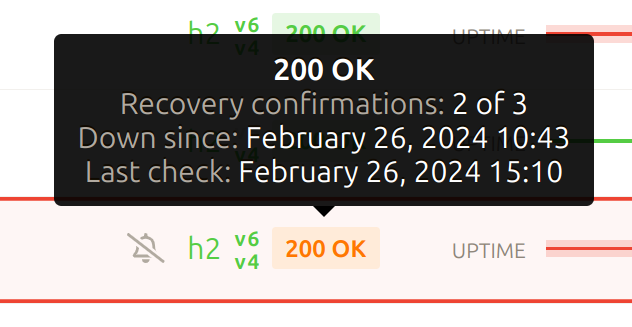Documentation How alerting works
We verify downtimes two additional times before notifying you, from at least one different location (so three down checks required in total). This is to avoid any false positive and very short glitch. To make the alerting as fast as possible, we perform these two verification checks twice as fast as your configured interval.
So for example: if you have configured a monitoring interval of 1min, and the first down check occurs at 08:00:00, the first confirmation will run at 08:00:30 (from a different location), and the second confirmation will run at 08:01:00. If after this confirmation your site is still down, that's when we send the alert (the downtime starting time will be recorded as 08:00:00 though).
This means that any downtime shorter than your check interval (shorter than 1min in this example) will not be notified. And any downtime longer than your check interval * 1.5 (longer than 1min30s in this example) is guaranteed to be notified. For any downtime between these two duration, it'll depend on how long the downtime was ongoing when we first noticed it.
Since 2024-02-26 The same thing happens at recovery, once a downtime is started, we'll require three up check to close the downtime. Like for downtime confirmation, these checks will run twice as fast and from at least two different locations. This help reduce the risk of false negative (e.g. closing a downtime after one lucky good checks while most other requests are still failing). It also helps reducing the amount of spam in case of flappy state (e.g. your website is only reachable from some locations or only responds to 25% of requests), updown will create fewer up/down/up/down alerts in this scenario.
It looks like this in the UI :

Reminders
If you check stays down for a long time, we also send "still down" reminder alerts (except by SMS to avoid the extra cost). The first reminder is sent after 60 down checks, so it scales automatically on your check frequency/importance. For example, with a 1min check interval the first reminder is sent after 1h, with a 1h check interval it would only be after 60h, and with 15sec check interval after only 15 min.
After the first reminder, each following reminder is sent after a polynomially increasing time delay (e.g. 1h, 2h, 4h, 8h, 16h...), this way you don't get spammed too much for a very long downtime, you get fewer and fewer reminders.
This is (in our opinion) a great default for most situation and cannot be configured. So if you want faster or slower reminders, consider increasing or decreasing your check interval.
Created on October 17, 2023 · Last update on August 27, 2025